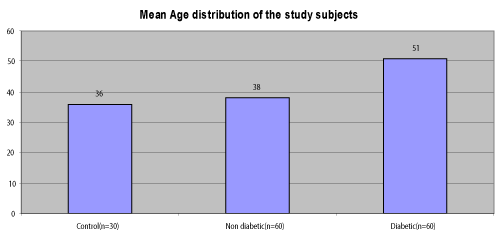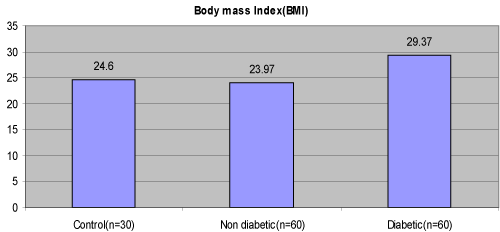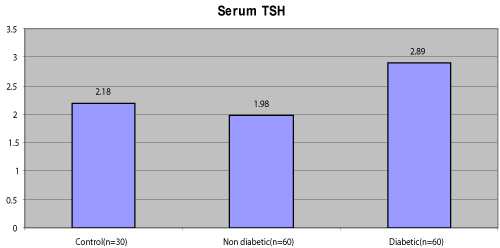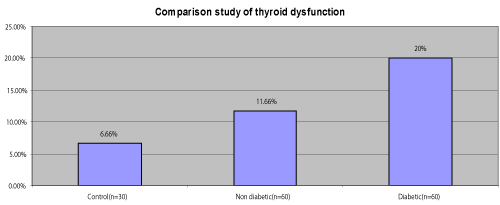| Research Article |
Open Access |
|
| Saha HR2, Sarkar BC1*, Khan SA1, Sana NK2 and Choudhury S1 |
| 1Bangladesh Institute of Research and Rehabilitation in Diabetes, Endocrine and Metabolic Disorders (BIRDEM), Bangladesh |
| 2Department of Biochemistry and Molecular Biology, University of Rajshahi, Bangladesh |
| *Corresponding author: |
Bidhan Chandra Sarkar
Scientific officer, General Laboratory
BIRDEM (Bangladesh Institute of Research
and Rehabilitation in Diabetes
Endocrine and Metabolic Disorders)
Shahbagh, Dhaka-1000, Bangladesh
Tel: +088-01720465323
E-mail: bidhan_sar@yahoo.com |
|
| Â |
| Received August 08, 2012; Published October 30, 2012 |
| Â |
| Citation: Saha HR, Sarkar BC, Khan SA, Sana NK, Choudhury S (2012) A Comparative Study of Thyroid Hormone and Lipid Status in Diabetic and Non Diabetic Adults. 1:450. doi:10.4172/scientificreports.450 |
| Â |
| Copyright: © 2012 Saha HR, et al. This is an open-access article distributed under the terms of the Creative Commons Attribution License, which permits unrestricted use, distribution, and reproduction in any medium, provided the original author and source are credited. |
| Â |
| Abstract |
| Â |
| The alteration of thyroid function in Type 1 and Type 2 diabetes has been shown in many studies. In previous two studies performed at BIRDEM on thyroid function, it has been found that thyroid functions were altered in diabetic subjects. The study population consisted of 120 subjects divided into two groups; diabetic (n=60) subjects and non diabetic (n=60) subjects with control (n=30) subjects. In order to clarify the mechanism of impaired thyroid hormone levels in patients with diabetes, blood glucose, glycosylated hemoglobin (HbA1C), lipids, thyroid stimulating hormone(TSH), free T4 (FT4) was observed in diabetic patients compared to non diabetic and control subjects. The mean age and body mass index (BMI) were significantly (p<0.001) increased in diabetic patients compared to non diabetic and control patients. A significantly (P<0.001) increased in the levels of serum cholesterol, triglyceride, lowdensity lipoprotein (LDL-C) were observed in diabetic patients compared to non diabetic and control subjects, and high density lipoprotein (HDL-C) were significantly (P<0.05) decreased in diabetic patients compared to non diabetic patients. The level of TSH in diabetic patients were significantly (P<0.05) increased compared to non diabetic and control subjects. But free T4 did not differ significantly in diabetic patients compared to non diabetic and control subjects. In conclusion, our findings demonstrate that detection of dyslipidemia and abnormal thyroid hormone levels in the early stage of diabetes mellitus will help the patients to improve quality of life and reduce the morbidity rate. |
| Â |
| Keywords |
| Â |
| Diabetes mellitus; Glycosylated hemoglobin; Lipid profile; Hypothyroidism; Hyperthyroidism |
| Â |
| Introduction |
| Â |
| Diabetes mellitus is an important health problem affecting major populations worldwide. Bangladesh has the dubious distinction of being home to the huge number of people suffering from diabetes in any country. A recent study by the World Health Organization (WHO) estimated that the worldwide prevalence of diabetes in 2002 was 170 million, with the number predicted to grow to 366 million or more by 2030. Lipids (fats), together with proteins and carbohydrates are the main components of living cells. Cholesterol and triglycerides are lipids that are stored in the body and serve as a source of energy in addition to their role in cell structure. When lipid levels in the bloodstream are too high or low, this condition is called dyslipidemia. In our study, the levels of serum lipids were found to be elevated in diabetic patients. Thyroid disorders are one of the most important public health problems of the world [1]. Hypothyroidism and hyperthyroidism is a common cause of secondary dyslipidemia. This observation is partly related to the hyperlipidemia known to be present in patients with both primary and secondary hypothyroidism [2]. Several cross-sectional studies have reported increased levels of total cholesterol and low-density lipoprotein (LDL) cholesterol in adults with sub clinical hypothyroidism compared with euthyroid controls [3]. In adults, increasing levels of TSH to be associated with increases in total cholesterol, LDL cholesterol and triglycerides and with decreases in HDL cholesterol [4-6]. In healthy euthyroid adults, both serum TSH and the free T4 value have been found to be positively associated with fasting and post load insulin concentrations and negatively associated with insulin sensitivity [7]. The present investigation is an attempt to study how diabetes affects thyroid function and lipid metabolism in euthyroid individuals and conversely how thyroid diseases could affect glycemic control. Thyroid function is affected in Diabetes. Hypothyroidism among diabetics has been frequently encountered [8,9]. The major disorders of thyroid gland are hyperthyroidism and the world with 1.6 billion people at risk [10,11]. Diabetes patients have a higher prevalence of thyroid disorders than the normal population [12]. Many women develop thyroid disease in association with pregnancy or menopause. There is a complex relationship between the thyroid, sex, adrenal and sugar-controlling hormones; if one goes off, the others often follow [13]. The problem of thyroid disorder is extensive in our country, even more than that of other developing countries [14]. Defects in carbohydrate metabolizing machinery and consistent efforts of the physiological system to correct the imbalance in carbohydrate metabolism place an overexertion on the endocrine system. Continuing deterioration of endocrine control exacerbates the metabolic disturbances and leads primarily to hyperglycemia [15-17]. The adoption of a sedentary lifestyle, the consumption of non-traditional foods, and a genetic predisposition to the disease are thought to be the major underlying causes of the epidemic [18]. The influence of endocrine and non-endocrine organs other than the pancreas on diabetes mellitus is documented. Occasionally, other endocrine disorders such as abnormal thyroid hormone levels are found in diabetes [19]. The physiological and biochemical interrelationship between insulin and the influence of both insulin and iodothyronines on the metabolism of carbohydrates, proteins, and lipids are recorded [20]. Only a handful number of publications are available in this field some of which are worth mentioning. An hypothyroidism, which have been reported in over 110 countries of association between the level of carbohydrate in take and T3 production from T4 was first demonstrated by Danforth et al. [21] in animal. There is evidence from animal studies that the function of the thyroid gland itself may be altered in diabetes mellitus [22]. T3 production from peripheral T4 mono-denomination is impaired in uncontrolled diabetes mellitus and this impairment is correlated with the impaiment of glucose utilization. Similar findings were later observed in another investigation by them on September 1979 and they emphasized that glucose uptake and utilization are important in the regulation of thyroid hormone metabolism by assessing thyroid hormone turn over in diabetic patient [23]. In untreated insulin requiring diabetic patients TSH remained suppressed and T3 and T4 remained low. Measurement of T3 and T4 are therefore not reliable indicator of thyroid status in the untreated insulin requiring diabetic patient [24]. Regulation of TSH secretion is altered in diabetes mellitus during decompensate state and normalizes when euglycemia achieved [25,26]. Concentration of free rather than total plasma hormones and other workers have observed that in contrast to free T3, free T4 may be normal or even elevated in other non thyroidal diseases [27,28]. |
| Â |
| Materials and Methods |
| Â |
| Study population |
| Â |
| This was a prospective study carried out in the department of Endocrinology, BIRDEM (Bangladesh Institute of Research and Rehabilitation in Diabetes, Endocrine and Metabolic Disorders) - WHO collaborating center for prevention and control of diabetes, Dhaka, Bangladesh during the period of January, 2012 to May 2012. |
| Â |
| In this study population consisted of 120 subjects (Age between 18-70 years; and Sex matched) who were divided into two groups: Diabetic 60 subjects (male-30, female-30) and non diabetic 60 subjects (male-30, female-30). Age and sex-matched healthy volunteers without a history of diabetes were considered being control 30 subjects. General health characteristics such as age, sex, smoking status, family status, family history, treatment status and Biophysical characteristics (particularly as related to preference) were investigated by a self-administered questionnaire. All the patients in the diabetic group were confirmed diabetics who previously had fasting plasma glucose levels and plasma glucose at 2 hours of OGTT/ After breakfast >7.0 mmol/L and >11.0 mmol/L, HbA1C>6.0% and who were receiving treatment such as insulin, Diet, anti-diabetic drug-glybenicide, glucophage, or physical exercise therapy for diabetes mellitus. In addition, none of the subjects had a history of previous thyroid disease. |
| Â |
| Laboratory procedure |
| Â |
| Consent was taken for each subject and they were requested to fast overnight. Blood samples were collected by venepuncture from patients and control. The samples were allowed to clot and the serum separated by centrifugation at 10,000 rpm for 15 minutes at room temperature. Serum samples were stored at -20°C until tested. Blood samples were treated as follows: - For Free T4, TSH and lipid estimation 4 ml of blood was taken in a plain test tube and was separated by centrifugation. For glucose estimation 1 ml of blood was placed in a tube containing fluoride. For estimation of HbA1C, 1 ml of blood was taken in a separate test tube containing EDTA. The plasma was separated and analyzed within a few hours of collection. Plasma glucose and serum lipids (Triglyceride, Total cholesterol and HDL cholesterol) were measured in the BIRDEM Biochemistry laboratory, Dhaka, by enzymatic method and mentioned briefly. The LDL cholesterol was calculated from observed triglyceride, total cholesterol and HDL cholesterol by using Fried-wald’s formula (If Triglyceride result is below 400 mg/dL). If Triglyceride result is upon 400 mg/dL used, direct LDL measurement method follows. |
| Â |
| Biochemical investigation |
| Â |
| The levels of serum thyroid stimulating hormone (TSH), free thyroxine (FT4) were measured by a Chemiluminescent Micro particle Immunoassay (CMIA) on ARCITECT System (Abbott Laboratories, Abbott Park, USA). The level of blood glucose, lipid profile and HbA1C were measured by Dade Behring auto analyzer. The normal value of FT4=(11.0-24.0) pmol/L and TSH=(0.40- 5.0) IU/mL. Desirable levels of blood fats are: Total cholesterol; below 200 mg/dL, triglyceride; below 150 mg/dl, HDL cholesterol; Men: above 40 mg/dL, Women: above 50 mg/dL, LDL cholesterol below 150 mg/dL. |
| Â |
| Results |
| Â |
| Statistical analysis |
| Â |
| All data were expressed as mean ± SD of the number of experiments. The statistical significance was evaluated by Student’s t-test, Correlation-Coefficient test (Two-tailed) using SPSS version 15.0 (SPSS, Cary, NC USA). |
| Â |
| Information about the demographic characteristics of the study population was shown in table 1. The mean age of diabetic subjects (51.36 ± 12.26) were significantly (P<0.001) increased compared with that of non diabetic subjects (38.61 ± 13.30). The body mass index diabetic subjects was (29.37 ± 4.48 kg/m2) increased significantly (<0.05) compared with that of non diabetic subjects (23.97 ± 3.01 kg/m2). The markedly elevated hypertension subjects (53%) compared with that of non diabetic subjects (10%). Ex- smoker were markedly elevated in diabetic subjects (15%) compared with that of non diabetic subjects (7%). |
| |
| Â |
|
|
Figure 1: Graphical data representation: (Table 1). |
|
| Â |
|
|
Table 1: Comparison of demographic characteristics of non-diabetic and diabetic subjects. |
|
| Â |
| Table 2 shows the levels of various biochemical parameters in diabetic and non-diabetic subjects. Blood glucose fasting and postprandial, HbA1C, serum triglyceride, Total cholesterol, LDL-C were significantly increased in diabetic subjects (8.33 ± 3.87***, 12.74 ± 5.53***, 9.03 ± 2.33***, 194.01 ± 70.51**, 195.26 ± 49.76*, 119.25 ± 40.72*) compared with that of non-diabetic subjects (5.16 ± 0.80, 6.51 ± 0.95, 5.43 ± 0.39, 155.35 ± 61.15, 178.70 ± 33.81, 106.71 ± 23.95) respectively, and HDL-C levels were significantly decreased in diabetic subjects (36.91 ± 7.37*) when compared with that of non-diabetic subjects (39.46 ± 6.88). |
| Â |
|
|
Figure 2: Graphically data representation: (Table-2). |
|
| Â |
|
|
Table 2: Comparison of biochemical changes in non diabetic and diabetic subjects. |
|
| Â |
| Table 3 illustrates the levels of serum thyroid hormones in diabetic and non-diabetic subjects. The level of serum TSH were increased significantly (P<0.05) in diabetic subjects (2.89 ± 2.73*) compared with that of non-diabetic subjects (1.98 ± 1.72). But FT4 did not differ significantly in diabetic subjects (16.70 ± 8.85 NS) compared with that of non-diabetic subjects (15.27 ± 6.68). |
| Â |
|
|
Figure 3: Graphically data representation: (Table-3). |
|
| Â |
|
|
Table 3: Comparison of serum thyroid hormone levels in non-diabetic and diabetic subjects. |
|
| Â |
| Table 4 shows the distribution of diabetic and non diabetic subjects with high, low, and euthyroid thyroid hormone levels. Total 60 diabetic subjects studied, among them 20% were thyroid dysfunction, where as 5% were sub clinical hypothyroidism, 6.66% were overt hypothyroidism, 6.66% were sub clinical hyperthyroidism and 1.66% was overt hyperthyroidism. The incidence of thyroid dysfunction was significantly higher in diabetic subjects (20%) than in non diabetic subjects (11.66%). The incidences of overt hypothyroidism were significantly (P<0.05) increases in diabetic female subjects (6.66%) compared with that of non diabetic female subjects (1.66%). |
| Â |
|
|
Figure 4: Graphically data representation: (Table-4). |
|
| Â |
|
|
Table 4: The distribution of subjects with high, low, or euthyroid thyroid hormone levels in non-diabetic and diabetic with control subjects. |
|
| Â |
| Table 5 shown, TSH levels were positively correlated with triglyceride (r=0.248*, p<0.05), Cholesterol (r=0.0.292*, p<0.023). On the other hand, free T4 levels were inversely correlated with Postprandial blood glucose levels (r=−0.260*, p<0.045), Cholesterol (r=-0.310*, p<0.016), HDL (r=-0.324*, p<0.05). |
| Â |
|
|
Table 5: Correlation of serum FT4, TSH with Cholesterol, Triglyceride, HDL, LDL, Fasting blood glucose, postprandial blood glucose (PPG) and HbA1C in the study subjects (Diabetic individuals). |
|
| Â |
| Discussion |
| Â |
| It is found that diabetes mellitus may be associated with altered thyroid functions. But this phenomenon has been observed mainly in Type 1 and Type 2 diabetic patients. In Bangladesh a substantial number of young diabetic patients do not show typical characteristics of either Type 1 or Type 2 diabetes mellitus. Three studies have previously been performed at BIRDEM on thyroid functions and alteration of their thyroid function has been found. For a more conclusive comment the better indicators of thyroid dysfunction, free T3, free T4 are necessary. It is also important to explore the thyroid autoimmunity and morphological changes for better understanding of thyroid dysfunction in these subjects. The presence of both high and low levels of thyroid hormones in diabetics in this study may also be due to modified TRH synthesis and release and may depend on the glycemic status of the diabetics studied. Glycemic status is influenced by insulin, which is known to modulate TRH and TSH levels [29]. This finding is probably associated with the higher prevalence of obesity recorded in female diabetics. In theory, treating diabetes should be simple: just prevent hyperglycemia from hypoglycemia to cause coma. In practice, it does not work that way. Glucose fluctuations occur all the time. One way to assess the mean levels is to monitor the HbA1c, which gives the average blood glucose level of the preceding 2-3 months. In uncontrolled or poorly controlled diabetes there is an increased glycosylation of a number of proteins, including hemoglobin. |
| Â |
| HbA1C was found to increase in patients with diabetes to approximately 16%, and the amount of increase was directly proportional to the fasting blood glucose level. During diabetes, the excess glucose present in blood reacts with hemoglobin [30,31]. In the present study, we noticed a marked increase in HbA1C levels in diabetic patients, which could be due to excessive glycosylation of hemoglobin. Thyroid function regulates a wide array of metabolic parameters. Thyroid function significantly affects lipoprotein metabolism as well as some cardiovascular disease (CVD) risk factors, thus influencing overall CDV risk [32-34]. Indeed, even within the normal range of thyroid-stimulating hormone (TSH) values, a linear increase in total cholesterol (TC), low-density lipoprotein cholesterol (LDL-C) and triglycerides (TGs) and a linear decrease in high-density lipoprotein cholesterol (HDL-C) levels has been observed with increasing TSH [35]. The marked hyperlipidemia that characterizes the diabetic state may therefore be regarded as a consequence of the uninhibited actions of lipolytic hormones on fat depots [5]. The increase and fall in the individual lipoprotein levels is a reflection of the total serum cholesterol levels; that is, the levels of VLDL-C, LDL-C, and HDL-C increase or decrease with the level of total serum cholesterol, and it is their ratio that determines the pathophysiology of lipoprotein metabolism [36,37]. Early diagnosis, good glycaemic control and dietary modification are usually enough for prevention and treating hyperlipidemia and thyroid dysfunction in diabetes mellitus. This study has shown a high incidence of abnormal thyroid hormone and lipid profile levels among diabetic patients. In conclusion, our findings demonstrate that detection of abnormal thyroid hormone and lipid profile levels in the early stage of diabetes will help patients improve their health and reduce their morbidity rate. Lipid abnormalities which are common in diabetic subjects are important etiological factor for atherosclerosis and coronary heart disease. Therefore, further prospective studies with larger number of patients are required to strengthen the observations of the present study. |
| Â |
| Acknowledgments |
| Â |
| The authors gratefully acknowledge the research facilities provided in the Department of Clinical Endocrinology Laboratory, BIRDEM, Dhaka, Bangladesh specially by Professor Dr. Subhagata Choudhury, Professor of Biochemistry and Director, Laboratory services, Dr. Shahidul Alam Khan, Chief Research Officer and Head, Dept. of Endocrinology, BIRDEM helped- the collect data, plan the study and also Dr. Niranjan Kumar Sana, Professor, Department of Biochemistry and Molecular Biology, University of Rajshahi, contributed to writing the paper, and helped with the discussion section. |
| Â |
| |
| References |
| Â |
- WHO/UNICEF/ICCIDD (1993) Global prevalence of iodine deficiency disorders-micronutrient deficiency information system (MDIS) 1: 5.
- O'Brien T, Dinneen SF, O'Brien PC, Palumbo PJ (1993) Hyperlipidemia in patients with primary and secondary hypothyroidism. Mayo Clin Proc 68: 860-866.
- Walsh JP, Bremner AP, Bulsara MK, O'leary P, Leedman PJ, et al. (2005) Thyroid dysfunction and serum lipids: a community-based study. Clin Endocrinol (Oxf) 63: 670-675.
- Pallas D, Koutras DA, Adamopoulos P, Marafelia P, Souvatzoglou A, et al. (1991) Increased mean serum thyrotropin in apparently euthyroid hypercholesterolemic patients: does it mean occult hypothyroidism? J Endocrinol Invest 14: 743-746
- Asvold BO, Vatten LJ, Nilsen TI, Bjoro T (2007) the association between TSH within the reference range and serum lipid concentrations in a population-based study. The HUNT Study. Eur J Endocrinol 156: 181-186.
- Bakker SJ, ter Maaten JC, Popp-Snijders C, Slaets JP, Heine RJ, et al. (2001) The relationship between thyrotropin and low density lipoprotein cholesterol is modified by insulin sensitivity in healthy euthyroid subjects. J Clin Endocrinol Metab 86: 1206-1211.
- Fernandez-Real JM, Lopez-Bermejo A, Castro A, Casamitjana R, Ricart W (2006) Thyroid function is intrinsically linked to insulin sensitivity and endothelium-dependent vasodilation in healthy euthyroid subjects. J Clin Endocrinol Metab 91: 3337-3343.
- Proces S, Delgrange E, Vander Borght TV, Jamart J, Donckier JE (2001) Minor alterations in thyroid-function tests associated with diabetes mellitus and obesity in outpatients without known thyroid illness. Acta Clin Belg 56: 86-90.
- Michalek AM, Mahoney MC, Calebaugh D (2000) Hypothyroidism and diabetes mellitus in an American Indian population. J Fam Pract 49: 638-640.
- Nakazono M, Kudo M, Baba T, Kikuchi H, Takebe K (1983) Thyroid abnormalities in diabetes mellitus. Tohoku J Exp Med 141: 275-281
- Alam Khan , Muzaffar Ali Khan, Shamim Akhter (2002) Thyroid Disorders, Etiology and Prevalence. J Med Sci 2: 89-94.
- Wu P (2000) Thyroid disease and diabetes. Clinical Diabetes18: 38.
- Cheikin M (2009) Thyroid Disease: The Hidden Epidemic. Holistic Medicine and Physiatry: 610-239-8626.
- Alam F (1998) Importance of Detailed History in the Evaluation of Thyroid Hormone Levels. Diab Endocr J 26: 59-62.
- Tiwari AK, Madhusudana Rao J (2002) Diabetes mellitus and multiple therapeutic approaches of phytochemicals: Present status and future prospects. Current Science 83: 30-38.
- G Saravanan, L Pari (2007) Effect of an herbal drug, cogent db on plasma and tissue glycoproteins in alloxan-induced diabetic rats. Res J Med Plant 1: 83-91.
- Bobb A, Gale D, Manmohan S, Mohammed A, Seetahal F, et al. (2008) The impact of the chronic disease assistance plan (CDAP) on the control of type 2 diabetes in Trinidad. Diabetes Res Clin Pract 80: 360-364.
- Wild S, Roglic G, Green A, Sicree R, King H (2004) Global prevalence of diabetes: Estimates for the year 2000 and projections for 2030. Diabetes Care 27: 1047-1053.
- Perros P, McCrimmon RJ, Shaw G, Frier BM (1995) Frequency of thyroid dysfunction in diabetic patients: value of annual screening. Diabet Med 7: 622-627.
- Dias CM, Nogueira P, Rosa AV, De Sa JV, Gouvea MF, et al. (1995) Total cholesterol and high-density lipoprotein cholesterol in patients with non-insulin-dependent diabetes mellitus.Acta Med port 8: 619-628.
- Danforth E, Sims EA, Harton ES, Goldman RS (1975) Correlation of serum triiodothyronine concentration with dietary composition, gain in weight and thermo genesis in animal. Diabetics 24: 406.
- Bagchi N, Brown TR, Shivers B, Lucas S, Mack RE (1981) Decreased thyroidal response to thyrotropin in diabetic mice. Endocrinology 109: 1428-1432.
- Pittman CS, Chamber JB Jr, Read VH (1971) The extrathyroidal conversion rate of thyroxine to triiodothyronine in normal man. J Clin Inv 50: 1187-1196.
- Saunders J, Hall SE, Sönksen PH (1978) Thyroid hormones in insulin requiring diabetes before and after treatment. Diabetologia 15: 29-32.
- Kabadi UM (1984) Impaired pituitary thyrotroph function in uncontrolled type II diabetes mellitus: normalization on recovery. J Clin Endocrinol Metab 59: 521-525.
- Bagchi N, Palaniswami N, Desai H, Felicetta J, Brown TR (1988) Decreased thyroidal response to thyrotropin in type II Diabetes mellitus. Metabolism 37: 669-671.
- Carter JN, Eastman CJ, Corcoran JM, Lazarus L (1974) Effect of severe, chronic illness on thyroid function. Lancet 2: 971-974.
- Jack H Oppenheimer, Ricardo Squee, Martin I Surks, Harold Hauer (1963) Binding of thyroxine by serum proteins evaluated by equilibrium dialysis and electrophoretic techniques. Alterations in non-thyroidal illness. J Clin Invest 12: 1769-1782.
- Reusch CE, Tomsa K (1999) Serum fructosamine concentration in cats with overt hyperthyroidism. J Am Vet Med Assoc 215: 1297-1300.
- Gloria-Bottini F, Antonacci E, Bottini N, Ogana A, Borgiani P, et al. (2000) RH blood groups and diabetic disorders: is there an effect on glycosylated hemoglobin level? Hum Biol 72: 287-294.
- Sampson MJ, Gopaul N, Davies IR, Hughes DA, Carrier MJ (2002) Plasma F2 isoprostanes: direct evidence of increased free radical damage during acute hyperglycemia in type 2 diabetes. Diabetes Care 25: 537-541.
- Duntas LH (2002) Thyroid disease and lipids. Thyroid 12: 287-293.
- Friis T, Pedersen LR (1987) Serum lipids in hyper- and hypothyroidism before and after treatment. Clin Chim Acta 162: 155-163.
- Canaris GJ, Manowitz NR, Mayor G, Ridgway EC (2000) The Colorado thyroid disease prevalence study. Arch Intern Med 160: 526-534.
- Oppenheimer JH (1979) Thyroid hormone action at the cellular level. Science 203: 971-979.
- al-Shamaony L, al-Khazraji SM, Twaij HA (1994) Hypoglycaemic effect of Artemisia herba alba. II. Effect of a valuable extract on some blood parameters in diabetic animals. J Ethnopharmacol 43: 167-171.
- Venkateswaran S, Pari L, Saravanan G (2002) Effect of Phaseolus vulgaris on circulatory antioxidants and lipids in rats with streptozotocin-induced diabetes. J Med Food 5: 97-103.
|
| Â |
| Â |




